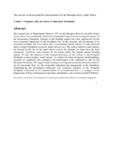Please use this identifier to cite or link to this item:
https://cris.library.msu.ac.zw//handle/11408/3233Full metadata record
| DC Field | Value | Language |
|---|---|---|
| dc.contributor.author | Dube, Trevor | - |
| dc.contributor.author | Wepener, V. | - |
| dc.contributor.author | van Vuren, J.H.J. | - |
| dc.contributor.author | Smit, N. | - |
| dc.contributor.author | Brendonck, L. | - |
| dc.date.accessioned | 2018-10-04T07:33:37Z | - |
| dc.date.available | 2018-10-04T07:33:37Z | - |
| dc.date.issued | 2015 | - |
| dc.identifier.issn | 1608-5914 | - |
| dc.identifier.uri | https://doi.org/10.2989/16085914.2015.1074061 | - |
| dc.identifier.uri | http://hdl.handle.net/11408/3233 | - |
| dc.description.abstract | The construction of Pongolapoort Dam in 1973 on the Phongolo River in KwaZulu-Natal, South Africa, has considerably altered the hydrological behaviour and ecological response of the downstream floodplain. Changes in the flooding regime have had implications for the socio-economic importance of the floodplain and for the structure and functioning of its associated wetlands. Previous studies have recommended annual releases of water from the dam to sustain floodplain ecosystem goods and services. The current artificial water releases are limited by the size of the dam's sluices and by the demand for water from the local community. Therefore, water releases do not always follow the original natural flooding regime. To date, the influence of the changed hydrology on the ecology of the Phongolo floodplain system remains poorly known. As a basis for future integrated interdisciplinary research we synthesised the ecological and hydrological work conducted to date on the Phongolo floodplain. We suggest hydro-ecology as an important research direction needed to set environmental flows for the sustainable utilisation and management of the floodplain. Understanding the hydrological behaviour and ecological response of the Phongolo floodplain could help in the implementation of environmental flows by managers at the Department of Water and Sanitation and other stakeholders such as Ezemvelo KZN Wildlife. | en_US |
| dc.language.iso | en | en_US |
| dc.relation.ispartofseries | African Journal of Aquatic Science;Vol. 40, No. 3: p. 269-276 | - |
| dc.subject | Conservation | en_US |
| dc.subject | Environmental flow requirements | en_US |
| dc.subject | Ndumo Game Reserve | en_US |
| dc.subject | Sustainable management | en_US |
| dc.title | The case for environmental flow determination for the Phongolo River, South Africa | en_US |
| dc.type | Article | en_US |
| item.cerifentitytype | Publications | - |
| item.openairetype | Article | - |
| item.grantfulltext | open | - |
| item.fulltext | With Fulltext | - |
| item.languageiso639-1 | en | - |
| item.openairecristype | http://purl.org/coar/resource_type/c_18cf | - |
| Appears in Collections: | Research Papers | |
Files in This Item:
| File | Description | Size | Format | |
|---|---|---|---|---|
| The case for environmental flow determination for the Phongolo River.pdf | Abstract | 191.11 kB | Adobe PDF |  View/Open |
Page view(s)
82
checked on Apr 20, 2025
Download(s)
6
checked on Apr 20, 2025
Google ScholarTM
Check
Items in MSUIR are protected by copyright, with all rights reserved, unless otherwise indicated.



